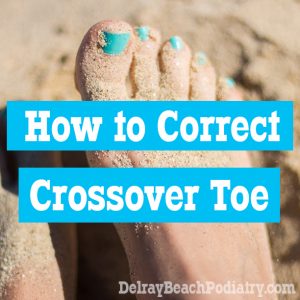Crossover toe is a condition in which the second toe drifts toward the big toe and eventually crosses over it entirely. This condition can occur at any age, although it is most often seen in adults.
Crossover toe is sometimes confused with hammertoe due to their similar appearance and the area they affect, however, these conditions have completely different causes and treatment methods.
In essence, crossover toe is a far more complex condition as hammertoes generally contract only in the sagittal plane (up and down) where as the crossover toe deformity is deviated in several different planes.
Causes
Crossover toe is typically the result of abnormal foot mechanics causing the ball of the foot beneath the second toe joint to take on an excessive amount of weight bearing pressure. This pressure eventually leads to a weakening of the ligaments and a failure of the joint to stabilize the toe, which sends your ailing extremity on its unwanted journey towards the big toe.
Certain conditions or characteristics can also make a person prone to experiencing excessive pressure on the ball of the foot. These most commonly include:
– Bunions
– A longer second toe than big toe
– An unstable arch
– Tight calf muscles
Symptoms
The pain caused by crossover toe usually begins in the bottom of the foot under the second toe. This condition typically occurs over a period of time, although it can appear more quickly if caused by injury or overuse.
As your toes continue to move and change shape, they can begin to rub the inside of your shoes, causing pain and swelling at the point of contact. For those who do not have adequate sensation in their lower extremities such as diabetics, this can become a significant risk for an ulceration and subsequent bone infection.
Treatment
In its early stages, crossover toe can be treated non-surgically by strapping the toe down in order to stabilize the joint and allow the toe to heal before it starts to deviate too much towards the big toe or even overlap the big toe.
Other non-surgical treatments include:
— Rest and Ice: Staying off the foot and applying ice packs help reduce the swelling and pain.
— Oral medications: Nonsteroidal anti-inflammatory drugs (NSAIDs), such as ibuprofen, may help relieve the pain and inflammation.
–Stretching. Keeping the calf muscles stretched will keep them from getting too tight.
— Custom Orthoics: In some cases, a podiatrist may need to craft a custom shoe insert are to provide added arch support or pads in order to redistribute your body weight away from the joint.
Unfortunately, once the second toe starts moving toward the big toe, it will never go back to its normal position unless surgery is performed.
For that reason, it’s important to be mindful of your feet in order to catch crossover toe in its early stages. Without treatment, the condition usually worsens to dislocation of the joint, so it is very beneficial to have a foot and ankle surgeon evaluate the foot soon after pain first occurs.
—
Follow Dr. Goldbaum on Twitter @Delray_Podiatry
The content on this website is for informational purposes only. Do not rely or act upon information from www.DelrayBeachPodiatry.com without seeking professional medical advice. If you live in South Florida and would like a consultation with Dr. Ian Goldbaum, a podiatric physician and surgeon with over 30 years of experience, please see our contact information below:
DELRAY BEACH
16244 S. Military Trail #290, Delray Beach, FL 33484
561-499-0033
BOCA RATON
2900 N. Military Trail #210, Boca Raton, FL 33431 (SOUTH BLDG)
561-499-2683
BOYNTON BEACH
8198 Jog Road #100, Boynton Beach, FL 33472
561-736-4002


One response
path of exile currency
Good !|Cool! I love your this bolg.